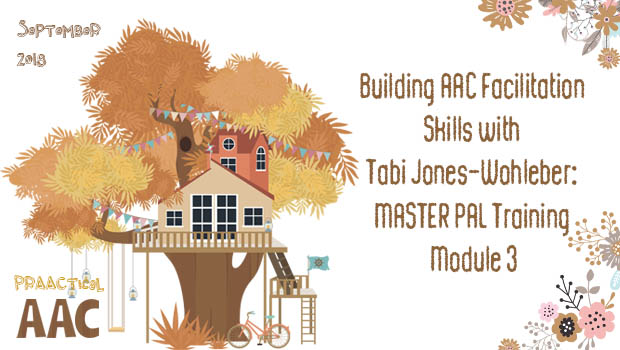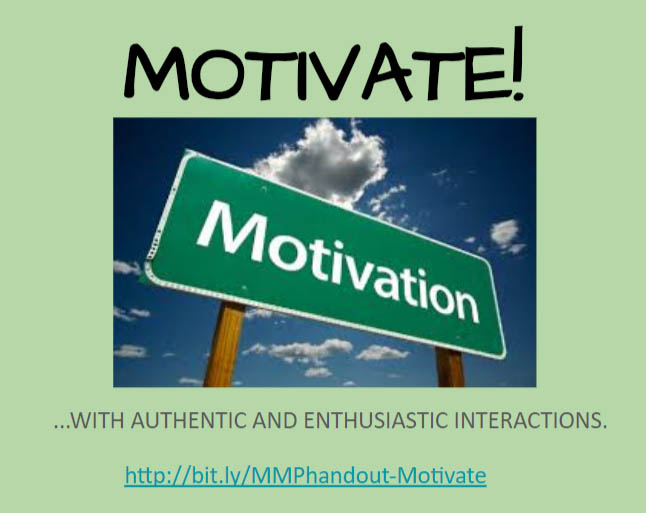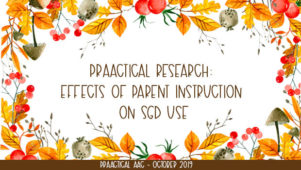Building AAC Facilitation Skills with Tabi Jones-Wohleber: MASTER PAL Training, Module 3

 Our training series continues with West Virginia-based SLP Tabi Jones-Wohleber, who works with the AT Team for Frederick County Public Schools in Maryland and provides services to infants and toddlers in the West Virginia Birth to Three programs. In the first two posts, Tabi shared the Overview and Modeling modules and their accompanying resources. In today’s post, the training focuses on an important topic, motivation.
Our training series continues with West Virginia-based SLP Tabi Jones-Wohleber, who works with the AT Team for Frederick County Public Schools in Maryland and provides services to infants and toddlers in the West Virginia Birth to Three programs. In the first two posts, Tabi shared the Overview and Modeling modules and their accompanying resources. In today’s post, the training focuses on an important topic, motivation.
:::::::::::::::::::::::::::::::::::::::::::::::::::::::::::::::::::::::::::::::::::::::::::::::::::::::::
Model as a MASTER PAL
Module 3: Motivate
Facilitator Guidelines
Genuine motivation goes well beyond gummies and goldfish; reinforcers are only one small part of the picture as we endeavor to understand what truly drives an individual’s desire to learn and communicate. So much of the time it is the quality of the relationship and the meaningfulness of the interaction. This module discusses the importance of motivation in learning and engaging, whether intrinsic or extrinsic, as well as the undesirable consequences that occur when lack of motivation results in compliance (or perhaps lack thereof LOL) rather than communication. Motivation is the driver in all of us. AAC can be hard. Make it worth it!
For this module, you will need
Warm-up Discussion:
| Thinking Prompt | Making Connections / Talking Points |
| How do you reward yourself for the little (& big) challenges in your life? | We all have things that we do to “keep us going”…..chocolate, wine, binge-watching NetFlix at the end of a long week. It’s important to recognize that kids need to know that their hard work (using AAC is hard work!), is valued, and worth it! |
| What do you do (in a social interaction)when the topic is not of interest to you? | Think about this….when you are at a party, at a staff meeting or other social event, and the topic turns to something you are not interested in you DO NOT engage in a meaningful way. You may listen, by probably not. Then you likely do one of the following: walk away, check your phone, send a text, get a drink, start a conversation with someone else. Bottom line: communication is inherently self-motivated. If we are interested in an interaction we don’t participate in it. |
| What does the pep-talk (in your head) sound like when you are trying to convince yourself to tackle a much-disliked task? | Most people tell themselves
When we use these strategies we are applying executive functioning skills. It is important to help kids learn to employ these strategies as well and honor their human limitations (which may look different from ours) to make tasks achievable and meaningful. Remember, when we are no longer interested, it is no longer communication, but rather compliance. |
| For our kiddos who use AAC, generating messages is hard work!
It HAS to be worth it for them to put forth the effort. |
A summary statement from the statements above. Ask participants if they have examples of how they have seen these ideas play out with students, or even themselves, their children or others they know. These discussion points are meant to spark an appreciation for the essence of our human nature, which is certainly applicable to our students who use AAC. |

The Discourse:
| Topics Addressed | Slide(s) | Talking Points / Examples |
| Title Slides | 1-2 | N/A |
| Communication Review | 3-7 | Review of Model as a MASTER PAL and AAC to ensure all participants are on the same page. |
| Introduction & Warm-up Discussion | 8-13 | Explained on Slides.
See chart above for Warm-up Discussion. |
| Joint Attention & Readiness | 14 | Communication starts with Joint Attention. From this place we can begin to engage a child, and foster readiness for learning and communicating. Motivation in paramount. |
| Understanding Motivation | 15-20 | Slide 16 – The images that come in with the slide, should be relatable to most: a sense of accomplishment, fortune, confidence that comes with preparedness. The animated images speak to what this may look like in many special education classrooms: a high five, primary reinforcer, or use of a tool to foster readiness.
Inherent in Readiness speaks to the importance of using visual supports such as visual schedules, to support receptive as well as expressive skills. This provides individuals greater autonomy in activities and transitions and provides a necessary sense of control. Slide 16 – Learned Helplessness: if the student isn’t motivated to do the work, the person assigned may feel sense of obligation to get it done and finish for them. |
| Communication Partner Behaviors | 21-22 | Communication partners have a responsibility to demonstrate respect when interacting with students. Awareness of all the ways that respect is conveyed helps us own our actions both conscious and unconscious. |
| Let’s Re-Cap | 23 |
|
Supplemental Handouts:
- Reinforcer Assessment (shared by Tracy Vail in the file section of the Angelman & Literacy Facebook group):
- Another Reinforcer Checklist
Video Links: NONE for this module
Interactive Activities / Discussions: (insert at any point in the presentation or complete at the end)
- Have participants complete the Reinforcer Assessment for someone they know, a student or child. Discuss how much variation there are the responses. We all have different needs and are motivated by different things. We should not assume we know what will motivate a child based on what has “worked in the past.” Some of the most effective strategies can come from being creative and thinking outside the box.
Extension Resources:
- American Speech and Hearing Association – Wow: The Big Difference a Tiny Toy Can Make
- Angelman Syndrome Foundation – Webinar #4: Aided Language Stimulation-Make It Interactive & FUN!
- Facebook Group: AAC Through Motivate, Model, Move Out of the Way
- PrAACtical AAC – “But he doesn’t like anything!” 5 Tools for Identifying Motivators and Reinforcement and more
- Speak For Yourself Blog – Year of Bubbles
Stay tuned for Module 4 in this training series. See you next week!
Filed under: Featured Posts, PrAACtical Thinking
Tagged With: AAC partner training, motivation, reinforcement, Tabi Jones-Wohleber
This post was written by Carole Zangari





4 Comments
Great resources, Tabi. Thanks for sharing
Thanks Tabi!
This is so important! Although I sometimes hear about motivation as a barrier, I feel like I don’t hear enough about being proactive in thinking about it. These are very practical and helpful ideas!
Hi Tabi! I’m translating these modules to portuguese, to present to parents and professionals from Brazil. On slide 8, in the facilitator’s notes in PPT, there is a mention to a Facebook post from Erin Sheldon. I’m friends with her on Facebook, but it is hard to pinpoint which motivational post you are referring to. Everything she writes is so on point and motivational! Can you send me the post or its contents? Thank you!
Carolina, if I can help, use the contact form to reach out to me, okay?